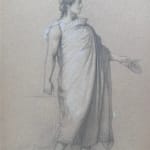Jean Auguste Dominique INGRES (Montauban 1780 – 1867 Paris)
30 x 18 cm
Further images
Provenance
Private collection, FranceThis male figure, seen in left profile, is dressed in a classical chlamys and wears laced sandals. He holds a round painter’s palette in his right hand and a bundle of brushes in his left — traditional attributes of the painter’s craft. These elements, along with the character’s placement in the final painting, clearly identify him as Apelles, the legendary Greek painter whom Ingres places beside Raphael among the artists paying homage to Homer in his celebrated Louvre composition (Salon of 1827, Louvre, INV 5417).
No other known preparatory drawing for Apelles was previously documented, making this sheet a significant addition to the artist’s corpus. Its execution — soft black chalk, sculptural volumes modeled by white highlights — is entirely consistent with Ingres’s autograph studies for The Apotheosis of Homer (cf. Iliad, Met Museum; Virgil, Harvard; Pindar, British Museum).
Inscription “à Mr Visconti”
The drawing is likely dedicated to Louis-Tullius Visconti (1791–1853), a young architect active in Paris by 1826, and known to have corresponded with Ingres (a letter is preserved at the Pierpont Morgan Library). Gifting a classical figure drawing to an architect deeply engaged with Greco-Roman art fits the period’s intellectual and social conventions.
The alternative hypothesis — Ennio-Quirino Visconti, who died in 1818 — remains open should earlier provenance emerge.
Join our mailing list
Join our mailing list to stay informed about our latest discoveries and upcoming exhibitions (once a month).
* denotes required fields
We will process the personal data you have supplied in accordance with our privacy policy (available on request). You can unsubscribe or change your preferences at any time by clicking the link in our emails.





